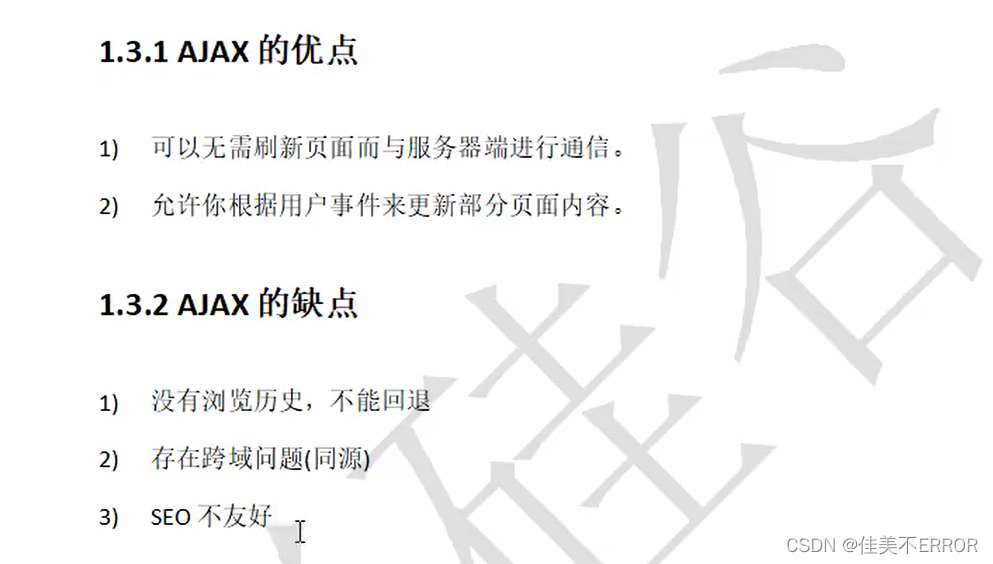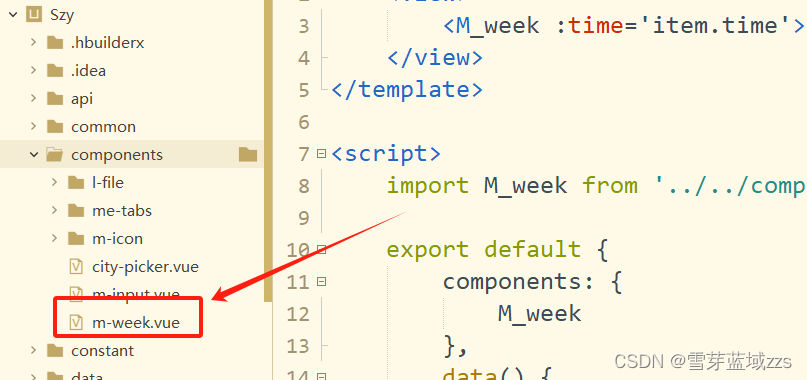Ajax的封装
一、最简单的原生Ajax封装
- 先看下效果

- 具体代码
<body>
<div class="box">
<button id="btn">来段数据</button><br>
<textarea id="text" ></textarea>
</div>
<script>
const btn = document.getElementById("btn");
const txt = document.getElementById("text");
btn.onclick = function(){
getAjax('get','https://api.apiopen.top/getJoke',function(res){
let narr=[];
for(let i=0;i<res.length;i++){
narr.push('n'+(i+1)+'.'+res[i].text)
console.log(res[i].text);
text.innerHTML=narr;
}
});
}
function getAjax(method,url,callback){
const xhr = new XMLHttpRequest();
xhr.open(method,url);
xhr.send();
xhr.onreadystatechange = function(){
if(xhr.readyState === 4){
if(xhr.status>=200 && xhr.status<300){
const res = JSON.parse(xhr.response);
callback(res.result);
}
}
}
}
</script>
二、使用promise函数封装
Promise是ES6引入的异步编程的新解决方案,语法上Promise是一个构造函数,用来封装异步操作并可以获取其成功或者失败的回调结果。
<script>
const btn = document.getElementById("btn");
btn.onclick = function(){
grtAjax('get','https://api.apiopen.top/getJoke',function(res){
console.log(res);
});
}
function grtAjax(method,url,callback){
const p = new Promise((resolve,reject)=>{
const xhr = new XMLHttpRequest();
xhr.open(method,url);
xhr.send();
xhr.onreadystatechange = function(){
if(xhr.readyState == 4){
if(xhr.status >= 200 && xhr.status < 300){
resolve(xhr.response);
}else{
reject(xhr.status);
}
}
}
});
p.then(function(value){
const res = JSON.parse(value);
callback(res.result)
},function(reason){
console.error(reason);
})
}
</script>

三、promise配合async和await使用
- async和await两种语法结合可以让异步代码像同步代码一样
- async函数的返回值为promise对象
- 该promise对象的结果是由async函数执行的返回值决定的
- 只要返回值的类型不是一个promise类型的对象则async函数的返回结果就是一个成功的promise对象
- 返回值的类型不是一个promise类型的对象则跟promise对象的状态有关revolve或者reject或者抛出异常
- await右侧的表达式一般为promise对象,但也可以是其他的值
- 如果是promise对象,await返回的是promise成功的值
- 如果是其他的值,直接将此值作为await的返回值
- await必须写在async函数中,但是async函数中可以没有await
- 如果await的promise状态是失败的,就会抛出异常,需要通过try…catch捕获处理

<body>
<button>请求数据</button>
<script>
const btn = document.querySelector('button');
function sendAjax(method,url){
return new Promise((resolve,reject)=>{
const xhr = new XMLHttpRequest();
xhr.responseType = 'json';
xhr.open(method,url);
xhr.send();
xhr.onreadystatechange = function(){
if(xhr.readyState === 4){
if(xhr.status >=200 && xhr.status<300){
resolve(xhr.response);
}else{
reject(xhr.status);
}
}
}
})
}
btn.addEventListener('click',async function(){
let result = await sendAjax('get','https://api.apiopen.top/getJoke');
console.log(result);
})
</script>
</body>
四、使用axios工具库直接发送Ajax
Axios 是一个基于 promise 网络请求库,作用于node.js 和浏览器中。 它是 isomorphic 的(即同一套代码可以运行在浏览器和node.js中)。在服务端它使用原生 node.js http 模块, 而在客户端 (浏览端) 则使用 XMLHttpRequests。
get

<template>
<div>
<button @click="post">直接发送POST</button>
<button @click="get">直接发送GET</button>
</div>
</template>
<script>
export default {
data(){
return{}
},
methods:{
async get(){
const {data:res} = await this.$axios.get('https://api.apiopen.top/getJoke',{
params:{id:1}
});
console.log(res);
},
post(){
this.$axios.post('https://api.apiopen.top/getJoke',{name:'yxj',gender:'男'})
.then((res)=>{
console.log(res.data.result);
});
}
}
}
</script>
原文地址:https://blog.csdn.net/weixin_51445423/article/details/124332172
本文来自互联网用户投稿,该文观点仅代表作者本人,不代表本站立场。本站仅提供信息存储空间服务,不拥有所有权,不承担相关法律责任。
如若转载,请注明出处:http://www.7code.cn/show_35168.html
如若内容造成侵权/违法违规/事实不符,请联系代码007邮箱:suwngjj01@126.com进行投诉反馈,一经查实,立即删除!
主题授权提示:请在后台主题设置-主题授权-激活主题的正版授权,授权购买:RiTheme官网
声明:本站所有文章,如无特殊说明或标注,均为本站原创发布。任何个人或组织,在未征得本站同意时,禁止复制、盗用、采集、发布本站内容到任何网站、书籍等各类媒体平台。如若本站内容侵犯了原著者的合法权益,可联系我们进行处理。






